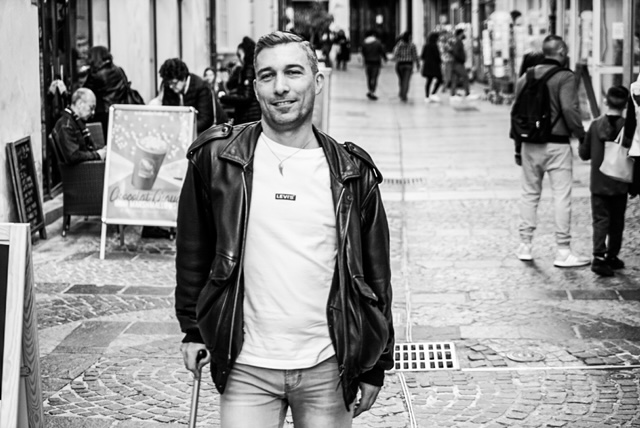Fibromyalgia: "If you fight against the illness, you'll never move forward."
Published 4 Sep 2024 • By Candice Salomé
Régis first noticed symptoms in 2019, beginning with severe dizziness that disrupted his daily life. His general practitioner quickly referred him to an ENT specialist, who conducted a series of tests. The results? Nothing. Six months later, the pain began to set in.
For the next four and a half years, Régis navigated through a diagnostic maze, consulting many healthcare professionals who dismissed his symptoms as “all in his head.”
Finally diagnosed, Régis now receives complete and multidisciplinary care. He is hopeful that he can soon return to a normal life, filled with the travel adventures he once enjoyed.
Discover his full story!

Hello Régis, thank you for agreeing to share your story with Carenity France.
Could you start by telling us a little more about yourself?
My name is Régis, I'm 48 years old, and I used to work as a freelance nurse. I live in Marseille in France, where I moved to join my partner in June 2023. We enjoy both cosy nights in watching series or movies and exploring the city, relaxing on the nearby beaches, and spending time with our families and friends.
I also have a soft spot for video games and reading.

You have fibromyalgia. Could you describe how the disease first appeared in your life? What were your initial symptoms, and what led you to seek medical advice?
In July 2019, during a holiday, I woke up one day with severe dizziness that was very disabling. I had to hold onto walls just to move around. After a few days, I decided to see my general practitioner, who quickly referred me to an ENT specialist.
The initial exams showed nothing, and neither did the scans. I was then hospitalized in the neurology department for further tests related to balance issues (neurology, ENT, ophthalmology, orthoptics, CT scans, MRIs, lumbar puncture, blood tests, neurological assessments... the list goes on). Still, nothing was found.
After about two weeks of rehabilitation to help me walk again, I returned home with a follow-up appointment scheduled with a neurology specialist. Six months of dizziness were soon followed by sudden, sharp, neuropathic pain—like electric shocks—in my arms and legs. My neurologist, overwhelmed by the negative results of all the tests, referred me to a neuroscientist colleague at La Timone Hospital in Marseille.
More tests followed, including genetic evaluations, but still, nothing concrete emerged. This diagnostic odyssey lasted four and a half years. Meanwhile, my pain worsened, becoming constant, diffuse, and continuous, punctuated by these paroxysmal attacks that are so disabling they cause me to drop objects or momentarily lose the use of a leg.
Since my first hospitalization, I have been using a cane to help me walk, both indoors and outdoors.
Following my last appointment with my neurologist in November, I requested to be referred to a pain management team. I’m currently on Level 2 analgesic treatment, which includes codeine and anti-epileptics, but I can't take anything stronger.
I had suspected fibromyalgia and mentioned it to my neuroscientist, but she dismissed the idea and made me feel guilty because she couldn’t find anything in the tests.
In December 2023, I finally saw a pain specialist (many thanks to a last-minute cancellation by another patient) who diagnosed me with widespread nociplastic pain.
The diagnosis was both a relief and a blow. I had expected just an initial consultation, and instead, I left with a diagnosis that was hard to accept.
As a pragmatic nurse, I tend to anticipate things based on available data about diseases, the patient’s overall environment, and clinical findings.
Fibromyalgia is a condition with a still-uncertain cause, although research is ongoing. Treatment largely depends on the doctors, who also have limited data about the disease (though, as I said, research is still ongoing), and the future remains uncertain as well.
It’s a lot to process.
What does your current treatment plan look like, and are you satisfied with it?
I’m currently under the care of a psychologist in the pain management team, supported by nurses providing Therapeutic Patient Education (TPE), a TENS workshop, and eventually, nonmedical treatments like self-hypnosis, mindfulness meditation, and heart coherence exercises.
In addition, I have a tailored physical activity plan (APA) that aligns with my daily capabilities and preferences, led by a certified instructor. This helps me manage my abilities on a day-to-day basis.
There’s also equine therapy and a movement and dance workshop available.
Right now, I’m working with a physiotherapist on flexibility, balance, muscle strengthening, and manual therapy, all combined with hydrotherapy.
I recently completed the TENS workshop and now use TENS daily as a baseline treatment. I’ll begin TPE next week.
At home, I’ve acquired a spiked mat, a rowing machine, resistance bands, and I use apps for stretching and walking.
Every healthcare provider I’ve encountered since my diagnosis—my GP, specialists, nurses, medical secretaries, physiotherapists, and physical medicine doctors—has been kind, attentive, and caring. It’s incredibly reassuring to finally feel heard and understood, rather than judged or dismissed, as I had been by the neuroscientist who insisted my symptoms were psychological.
I’m very satisfied with my current care. Everyone involved is adapting to my daily situation, considering my capabilities and even my preferences and refusals.
What treatments are you currently on, and do they work for you?
I’ve recently switched from codeine to tramadol, an opioid derivative. It’s a difficult choice between two tough options, but for now, I can’t do without it—not because of dependency, but because the pain severely disrupts my already fragile sleep.
Do you use any alternative therapies? If so, which ones, and how do they help?
I’ve been seeing an osteopath who uses gentle, soft manipulations that provide relief and relaxation. It’s a really soothing experience.
I’m also looking into cryotherapy sessions because they might help reduce pain by numbing the pain receptors.
How has fibromyalgia affected your professional life?
The diagnosis came after three years of sick leave, so I’m now fully disabled and unable to return to work.
I’m under a non-listed long-term illness and have also applied for a status with disabled parking and priority access cards.
How do your loved ones cope with your illness? Do they understand it, and do they support you?
My loved ones are caring and supportive. However, for some, the illness is a bit abstract because the only visible sign is my cane. The rest is invisible, and understanding what I’m going through can be challenging.
I often receive basic advice on things that are already resolved, which can be incorrect regarding how I function or how the disease itself works. Correcting them can sometimes be more exhausting than the illness itself.
But overall, they are loving, caring, and considerate. I also try not to focus too much on the illness. I want to be treated like everyone else, with the understanding of my limitations, of course.
What are your future plans?
My future is a bit uncertain at the moment. During a recent bone scan ordered by my pain specialist to check for potential bone inflammation and to rule out other diagnoses, a mass was discovered in my lung. I had an urgent appointment with a pulmonologist the next day and have a series of tests scheduled this week to determine what it is.
So, my immediate future involves these tests, ongoing pain management, learning to manage the pain, and hopefully resuming a somewhat normal life. I would love to get back to travelling, which is currently impossible for me.
Finally, what advice would you give to other Carenity members who are also living with fibromyalgia?
For anyone with fibromyalgia, I have two pieces of advice:
- Don’t give up, keep fighting. The initial stages of treatment may seem long—I’m still in that phase myself—but if you follow the healthcare professionals’ recommendations, you’ll be able to manage your daily life and your illness better.
- Don’t isolate yourself. Try to connect with an association, a fellow patient, your physiotherapist—anyone else with fibromyalgia. You’ll feel less alone, which is very important. Also, talk to your loved ones about your illness. They need to be “educated” about what’s happening to you, what you can and cannot do.
Any final words?
The first thing is to really accept this condition. If you fight against it, you’ll never move forward.
A big thank you to Régis for this interview!
Give it a “Like” and share your thoughts and questions with the community in the comments below!
Take care of yourself!

 Facebook
Facebook Twitter
Twitter


